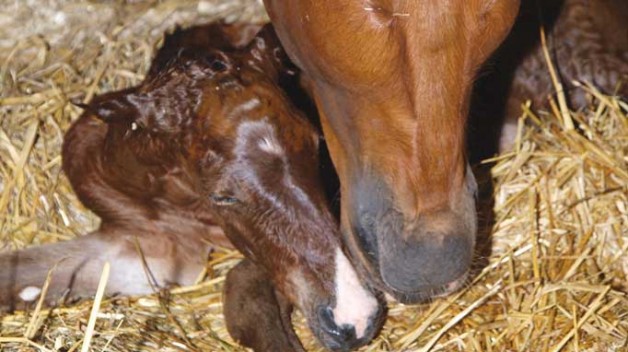For some breeders, the waiting game starts as soon as the mare is inseminated. For others, it starts when she’s confirmed in foal. Still for others, it starts when she her belly grows large. Whenever that waiting game starts, all breeders want to know: When will my mare foal?
Igor Canisso, DVM, MSc, PhD, Dipl. ACT, Dipl. ECAR, previously of the University of Kentucky Gluck Equine Research Center and now an assistant professor of equine theriogenology at the University of Illinois College of Veterinary Medicine, offered some tips on how to predict when a mare will foal.
Most deliveries transpire smoothly with no ill effects. But when a problem does occur—even a simple issue such as an easily correctable dystocia (difficult birth)—things can go south rapidly, Canisso said. Additionally, “in certain situations, we don’t want let the foal suckle on its dam due to risk of developing a condition such as neonatal isoerythrolysis,” or acute hemolytic anemia caused by ingesting antibodies in the mare’s colostrum and milk that are directed against the neonate’s red blood cells, he said.
“That’s why each foaling should be attended,” he explained. “If there is a simple problem, it can easily be corrected by an experienced foaling attendant. Or, if there is a more serious condition, the mare can be referred to a clinic, or a veterinarian can be called to check the mare.
“Usually, it is best not to wait (to call the veterinarian), as after 30 minutes from ‘water break,’ every 10-minute delay in foaling decreases the foal’s survival rate by 10%,” Canisso said.
And because the vast majority of foalings take place between 6 p.m. and 6 a.m., he said, it’s important to know when you might want to start brewing coffee for overnight foal watches.
Here are some of the options owners and veterinarians can use to predict when a mare will foal.
Estimated Foaling Date—The average equine gestation length is between 335 and 345 days. So you should be able to easily calculate your mare’s estimated foaling date if you know when she was bred. For example, if your mare was bred on Feb. 10 and has an average gestation, you can tentatively expect a foal between Jan. 12 and Jan. 22 of the following year. Canisso cautioned, however, that gestation length varies substantially between breeds, time of the year (it’s usually longer when the mare is due to foal in the late winter and early spring), and individual mares, so use this method only as a guide.
If you’re unsure of when your mare was bred, your veterinarian can perform an ultrasound exam to estimate the mare’s stage of pregnancy and calculate an estimated foaling date.
Physical Signs—As the mare’s due date approaches, start watching for physical signs indicating she’s preparing to foal, including:
- Tailhead relaxation—Canisso noted this is harder to identify in overweight, heavily muscled, or maiden mares;
- Vulva relaxation and elongation—Canisso cautioned that some older mares might have very pronounced vulvar relaxation well before foaling while others mares will show minimal or no appreciable changes, so don’t rely solely on this factor to predict foaling; and
- Mammary gland enlargement—Canisso said most mares’ mammary glands will begin getting larger about a month before their due date, with the most notable changes in the last two weeks prior to foaling. Maiden mares might not show substantial udder enlargement until close to parturition, he said.
Canisso cautioned that maiden mares might not display the same physical signs as seasoned broodmares.
Mammary Gland Secretions—For the last three decades many veterinarians and breeders have used mares’ mammary gland secretion electrolyte levels to predict foaling. In the normal mare, the mammary gland secretion’s calcium and potassium levels rise while sodium decreases closer to foaling. However, measuring these electrolytes to predict foaling requires a machine to analyze the levels and serial measurements. Canisso said that, commonly, breeders and veterinarians have submitted these electrolyte samples to a laboratory, which can be expensive and prohibit the practice’s use for mares not located close to a laboratory–essentially, most mares in most regions.
Because calcium is the most reliable and commonly used electrolyte, commercial kits are now available for breeders to use to estimate the mammary secretions’ calcium carbonate content and, thus, help predict when the mare will or will not foal. The commercial calcium carbonate test’s limitations include the costs and required dilutions to obtain an accurate reading, said Canisso.
Recently, Canisso and colleagues tested another method by which to predict foaling using mammary gland secretions. This time, however, they measured the secretions’ pH levels. Using commercially available pH test strips, owners can test the mammary gland secretions once daily; when the normally slightly basic secretions (pH> 8) drop to below 7 on the pH scale, the mare will likely foal within 24 hours, Canisso said. In his recent study, 11 of 14 mares foaled within 24 hours when their mammary gland secretion pH levels were 7 or lower; the remaining three study mares foaled without significant pH changes, he said.
In the same study, Canisso and colleagues compared the secretions’ pH levels with their calcium, sodium, and potassium concentrations. They found that the pH measurements were equally as effective as electrolyte measurements at predicting foaling, suggesting that pH can replace electrolyte measurements, he said. Canisso also noted that measuring pH is advantageous over electrolytes because the tests cost less; are more practical, as no dilutions are needed to determine pH; and require only a small drop of secretion to complete—this is especially beneficial for maiden mares, he said, as many maiden mares have a very small amount of pre-foaling mammary gland secretions, making electrolyte measurement very difficult.
Electronic Devices—Next, Canisso described some electronic devices breeders can use to alert them to impending foaling:
- The Foal-Alert is a magnetic device that a veterinarian sews into the mare’s vulva. When the magnets are separated as the vulva expands during foaling, an alert is sent to a pager or cell phone, or an alarm sounds in the barn. Canisso said while this device can be used successfully, it can also cause many false alarms. Additionally, the alarm might not sound if the foal is malpositioned in the uterus or if its feet don’t penetrate the mare’s vulva.
- The Breeders’ Alert is a position-monitoring device shaped like a small box that attaches to the mare’s halter and sounds an alarm when it detects that the mare is in lateral recumbency (the position in which they deliver a foal) for more than 15 seconds. Like the Foal-Alert, Canisso said, this device causes a lot of false alarms.
- The last device Canisso described is the Birth Alarm. Like the Breeders’ Alert, the Birth Alarm monitors a mare’s position; however this device is located on a surcingle. When the mare lies down for more than about 8 seconds, an alert is sent to the individual monitoring the mare. As with the other two devices, Canisso said this can throw false positives, and it might be cost-prohibitive for some breeders.
Video Monitoring Systems—Finally, Canisso noted that many breeders and veterinarians employ video monitoring systems that allow them to keep an eye on the mare for signs of foaling from afar.
So which method should breeders select? Canisso said many breeders opt for a combination of the available options to give themselves the best chance to accurately predict when a mare will foal.
“Since there isn’t a single and perfect way to predict foaling in all mares, the best approach is to combine different strategies to maximize the results,” he said.



